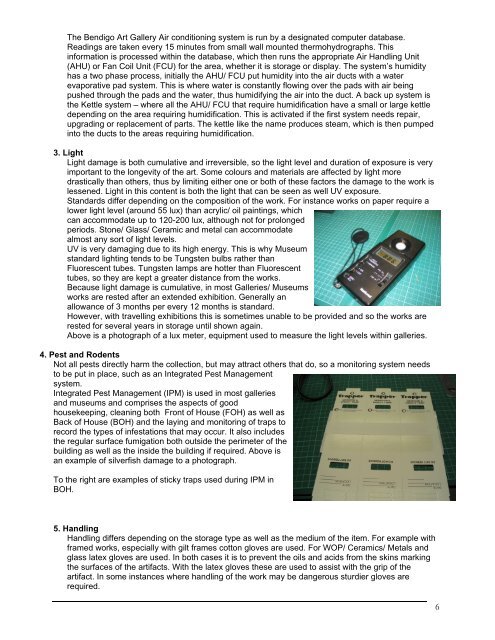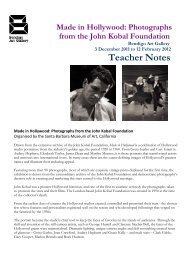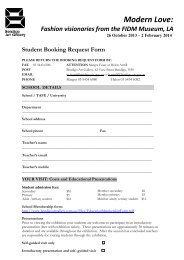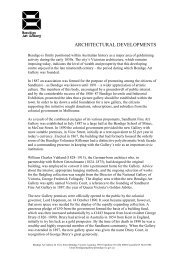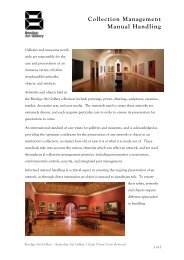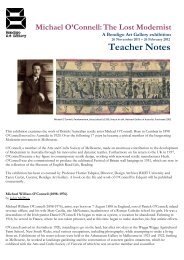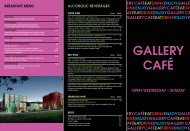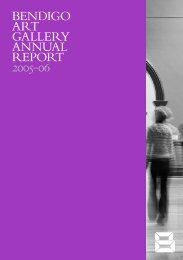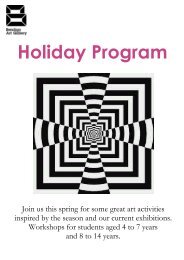Studio Arts Exam Revision booklet - Bendigo Art Gallery
Studio Arts Exam Revision booklet - Bendigo Art Gallery
Studio Arts Exam Revision booklet - Bendigo Art Gallery
Create successful ePaper yourself
Turn your PDF publications into a flip-book with our unique Google optimized e-Paper software.
The <strong>Bendigo</strong> <strong>Art</strong> <strong>Gallery</strong> Air conditioning system is run by a designated computer database.<br />
Readings are taken every 15 minutes from small wall mounted thermohydrographs. This<br />
information is processed within the database, which then runs the appropriate Air Handling Unit<br />
(AHU) or Fan Coil Unit (FCU) for the area, whether it is storage or display. The system’s humidity<br />
has a two phase process, initially the AHU/ FCU put humidity into the air ducts with a water<br />
evaporative pad system. This is where water is constantly flowing over the pads with air being<br />
pushed through the pads and the water, thus humidifying the air into the duct. A back up system is<br />
the Kettle system – where all the AHU/ FCU that require humidification have a small or large kettle<br />
depending on the area requiring humidification. This is activated if the first system needs repair,<br />
upgrading or replacement of parts. The kettle like the name produces steam, which is then pumped<br />
into the ducts to the areas requiring humidification.<br />
3. Light<br />
Light damage is both cumulative and irreversible, so the light level and duration of exposure is very<br />
important to the longevity of the art. Some colours and materials are affected by light more<br />
drastically than others, thus by limiting either one or both of these factors the damage to the work is<br />
lessened. Light in this content is both the light that can be seen as well UV exposure.<br />
Standards differ depending on the composition of the work. For instance works on paper require a<br />
lower light level (around 55 lux) than acrylic/ oil paintings, which<br />
can accommodate up to 120-200 lux, although not for prolonged<br />
periods. Stone/ Glass/ Ceramic and metal can accommodate<br />
almost any sort of light levels.<br />
UV is very damaging due to its high energy. This is why Museum<br />
standard lighting tends to be Tungsten bulbs rather than<br />
Fluorescent tubes. Tungsten lamps are hotter than Fluorescent<br />
tubes, so they are kept a greater distance from the works.<br />
Because light damage is cumulative, in most Galleries/ Museums<br />
works are rested after an extended exhibition. Generally an<br />
allowance of 3 months per every 12 months is standard.<br />
However, with travelling exhibitions this is sometimes unable to be provided and so the works are<br />
rested for several years in storage until shown again.<br />
Above is a photograph of a lux meter, equipment used to measure the light levels within galleries.<br />
4. Pest and Rodents<br />
Not all pests directly harm the collection, but may attract others that do, so a monitoring system needs<br />
to be put in place, such as an Integrated Pest Management<br />
system.<br />
Integrated Pest Management (IPM) is used in most galleries<br />
and museums and comprises the aspects of good<br />
housekeeping, cleaning both Front of House (FOH) as well as<br />
Back of House (BOH) and the laying and monitoring of traps to<br />
record the types of infestations that may occur. It also includes<br />
the regular surface fumigation both outside the perimeter of the<br />
building as well as the inside the building if required. Above is<br />
an example of silverfish damage to a photograph.<br />
To the right are examples of sticky traps used during IPM in<br />
BOH.<br />
5. Handling<br />
Handling differs depending on the storage type as well as the medium of the item. For example with<br />
framed works, especially with gilt frames cotton gloves are used. For WOP/ Ceramics/ Metals and<br />
glass latex gloves are used. In both cases it is to prevent the oils and acids from the skins marking<br />
the surfaces of the artifacts. With the latex gloves these are used to assist with the grip of the<br />
artifact. In some instances where handling of the work may be dangerous sturdier gloves are<br />
required.<br />
6


